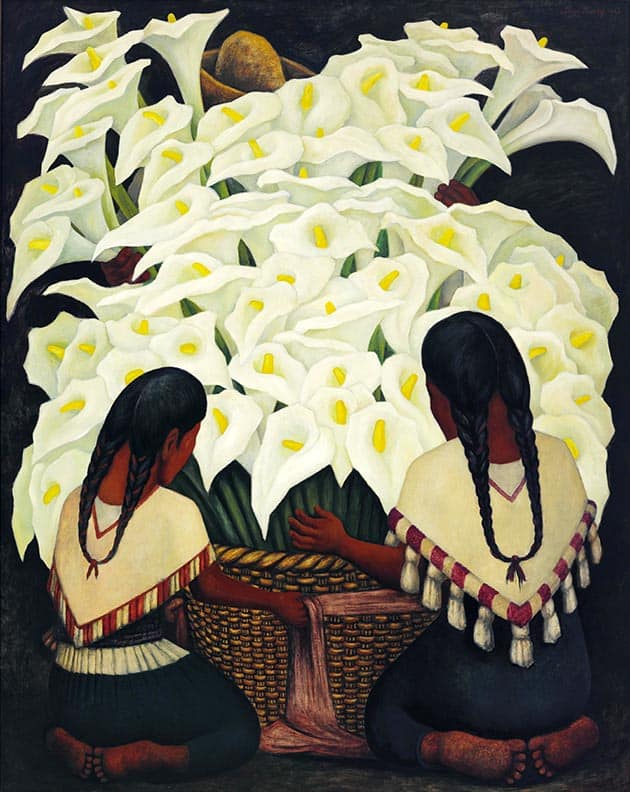Anyone who has heard of Diego Rivera’s stunning and controversial murals, or of Frida Kahlo’s intense explorations of oppression and sexuality will want to see the Art Gallery of NSW exhibition featuring the two Mexican artists. But manage your expectations, and supplement your visit with some wider reading and viewing to get a fuller sense of these artists’ revolutionary worlds and work.
The artworks on display are drawn from the collection that belonged to Mexican movie moguls Jacques and Natasha Gelman. Massive portraits of Natasha Gelman are the first and some of the largest paintings you see, and the artists’ most powerful works exploring the social and psychological tensions of the first half of the 20th century are conspicuously absent.
The curators pad out Kahlo’s self-portraits and Rivera’s lily-laden paintings with a narrative of all-consuming and tragic love affairs, spiked with the flavour of the Mexican revolution.
Aside from exiled Russian revolutionary Leon Trotsky’s cameo appearance on the timeline and in a video at the end, it is difficult to get a sense of the global ruptures that Rivera was responding to and helping to fuel. Some of this is unavoidable—Rivera’s most political works were murals, deliberately public art contrasting workers, peasants, indigenous Mexicans and Detroit factory workers in historical and contemporary struggle against idle and depraved rulers.
In 1938, Trotsky wrote, “Do you wish to see with your own eyes the hidden springs of the social revolution? Look at the frescoes of Rivera. Do you wish to know what revolutionary art is like? Look at the frescoes of Rivera.” But you will have to look online, as there is barely a shadow of this revolutionary impulse in this exhibition. Some worth investigating are: Wall Street Banquet (1928), Frozen Assets (1938) and most famously Man at A Crossroads (1934)—the mural commissioned and then destroyed by the Rockefeller family because Rivera refused to remove Lenin’s face!
Kahlo’s paintings are more internal and conjure the anguish of oppression, and a protest against it. Her debilitating injuries were obviously a source of endless physical pain and social isolation, but some of the artworks depicting physical injury communicate other kinds of torment.
The Little Deer (1946), A Few Small Nips (1935) and Henry Ford Hospital (1932) are just some of her paintings that acutely convey the brutality of sexism and the sense of dissociation and alienation from your own body that women’s oppression routinely generates. The exhibition includes some of Kahlo’s sketches that get at this theme, but not the final artworks.
Mexican revolution
Clearly the Mexican revolution was a touchstone for Kahlo. Her art is infused with the style and symbols of Mexican folk art and we are told that she saw her own life as so tied to it that she gave her birthdate as 1910, its first year. To understand what Kahlo was moved by, it’s worth reading Stuart Easterling’s three part series on the Mexican Revolution in International Socialist Review.
The strident and endless defiance of the peons (bonded agricultural labourers), the rapid social transformation and the bitter human sacrifice involved gives some context to Kahlo’s deep affection for the people who had fought long and hard against injustice.
Easterling’s series argues that the revolution was not complete; while the monumental struggle ensured that the ruling class was weakened and that land and social reforms were widespread, the working class and campesinos were incorporated into a state that remained a capitalist one. But it seems Rivera and Kahlo did not agree.
The exhibition makes much of Kahlo’s affair with Trotsky, but it doesn’t explain that she was an on and off member of the Stalinist Communist Party. Their Mexican nationalism was also at odds with Trotsky’s theory of permanent revolution. What is clear, though, is the sentimental nationalism in Rivera and Kahlo’s work; for Rivera, struggles of Mexicans are depicted as historical, or against the capitalists in the United States. For Kahlo, the tension in her work is an internalised struggle with a woman’s body; not explicitly externalised against the local Mexican ruling class.
There is a new wave of struggle in Mexico, with the Oaxaca teachers leading the fight against austerity and neo-liberalism. Notwithstanding their nationalism, the violence and pain of oppression and the transformative power of revolution that Rivera and Kahlo lived and painted are important wells of creative inspiration for Mexican revolutionaries, and anyone who wants justice. Make sure you go beyond this exhibition to get closer to the full effect.
By Lucy Honan
Frida Kahlo and Diego Rivera
Art Gallery NSW until 9 October
Tickets $16-$18






